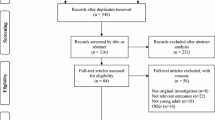Abstract
Exercise tolerance inversely correlates with the severity of the disease in patients with idiopathic pulmonary arterial hypertension (IPAH). Cycling and walking protocols are commonly utilized in the evaluation of exercise intolerance in IPAH, but little information exists on possible differences in ventilatory and gas exchange adaptations to these exercise modalities. In a group of patients with moderate to severe IPAH (n = 13), we studied the ventilatory, cardiovascular and gas exchange adaptations to maximal incremental walking (W) and maximal incremental cycling (C). During W, compared to C, the ventilatory equivalents for CO2 output (V′E/V′CO2) were significantly higher either expressed as the rate of increment (56 ± 5 vs. 45 ± 3; P < 0.0001) or as the absolute values at anaerobic threshold (AT) and at peak exercise. At AT, the increase in V′E/V′CO2 during W was associated with a significant lower value of end-tidal carbon dioxide. At peak W, compared to peak C, dyspnea sensation was higher and arterial oxygen saturation (SpO2) was lower (87 ± 2 vs. 91 ± 2, P < 0.001). In patients with IPAH the physiologic information obtained with W are different from those obtained with C. Tolerance to W exercise is limited by high ventilatory response and dyspnea sensation. W should be used to assess the degree of lung gas exchange inefficiency and arterial O2 desaturation during exercise.




Similar content being viewed by others
References
Beaver WL, Wasserman K, Whipp BJ (1973) On-line computer analysis and breath-by-breath graphical display of exercise function tests. J Appl Physiol 34:128–132
Castile R, Mead J, Jackson A, Wohl ME, Stokes D (1982) Effects of posture on flow-volume curve configuration in normal humans. J Appl Physiol 53(5):1175–1183
D’Alonzo GE, Gianotti LA, Pohil L, Reagle RR, DuRee SL, Fuentes F, Dantzker DR (1987) Comparison of progressive exercise performance of normal subjects and patients with primary pulmonary hypertension. Chest 92:57–62
Dantzker DR, Bower JS (1979) Mechanisms of gas exchange abnormality in patients with chronic obliterative pulmonary vascular disease. J Clin Invest 64(4):1050–1055
Dantzker DR, D’Alonzo GE, Bower JS, Popat K, Crevey BJ (1984) Pulmonary gas exchange during exercise in patients with chronic obliterative pulmonary hypertension. Am Rev Respir Dis 130:412–416
Deboeck G, Niset G, Vachiery JL, Moraine JJ, Naeije R (2005) Physiological response to the six-minute walk test in pulmonary arterial hypertension. Eur Respir J 26:667–672
Dejours P (1964) Control of respiration in muscular exercise. In: Handbook of physiology: respiration, vol I, Sect. 3, chapt 25. Am Physiol Soc, Washington DC, pp 631–638
European Society Cardiology (2004) The task force on diagnosis and treatment of pulmonary arterial hypertension of the European society cardiology. Guidelines on diagnosis and treatment of pulmonary arterial hypertension. Eur Heart J 25:2243–2278
Fukuchi K, Hayashida K, Nakanishi N, Inubushi M, Kyotani S, Nagaya N, Ishida Y (2002) Quantitative analysis of lung perfusion in patients with primary pulmonary hypertension. J Nucl Med 43:757–761
Guyatt GH, Sullivan MJ, Thompson PJ et al. (1985) The 6-minute walk: a new measure of exercise capacity in patients with chronic heart failure. Can Med Assoc J 132:919–923
Killian KJ, LeBlanc P, Martin DH, Summers E, Jones NL, Campbell EJM (1992) Exercise capacity and ventilatory limitation in patients with chronic airflow limitation. Am Rev Respir Dis 146:935–940
Man WD, Soliman MG, Gearing J, Rodford SG, Rafferty GF, Gray BJ, Polkey MI, Moxham J (2003) Symptoms and quadriceps fatigability after walking and cycling in chronic obstructive pulmonary disease. Am J Respir Crit Care Med 168(5):562–567
McGoon M, Gutterman D, Steen V, Barst R, McCrory DC, Fortin TA, Loyd JE (2004) Screening, early detection, and diagnosis of pulmonary arterial hypertension. Chest 126:14s–34s
Miyamoto S, Nagaya N, Satoh T, Kyotani S, Skamaki F, Fujita M, Nakanishi N, Miyatake K (2000) Clinical correlates and prognostic significance of six minute walk test in patients with primary pulmonary hypertension. Comparison with cardiopulmonary exercise testing. Am J Respir Crit Care Med 161:487–492
Onorati P, Antonucci R, Valli G, Berton E, De Marco F, Serra P, Palange P (2003) Non invasive evaluation of gas exchange during shuttle walking test vs six minute walking test to asses exercise tollerance in COPD patients. Eur J Appl Physiol 89(3–4):331–336
Palange P, Forte S, Onorati P, Manfredi F, Serra P, Carlone S (2000) Ventilatory and metabolic adaptations to walking and cycling in COPD. J Appl Physiol 88:1715–1720
Rich S, Dantzeker DR, Ayres SM, Bergofsky EH, Broundage BH, Detre KM, Fishman AP, Goldring RM, Grovers BM, Koerner Sk et al. (1987) Primary pulmonary hypertension: a national prospective study. Ann Intern Med 107:216–223
Riley MS, Pórszász J, Engelen MPKJ, Brundage BH, Wasserman K (2000) Gas exchange responses to continuous incremental cycle ergometry exercise in primary pulmonary hypertension in humans. Eur J Appl Physiol 83:63–70
Singh SJ, Morgan MDL, Scott S, Walters D, Hardman AS (1992) Development of a shuttle walking test of disability in patients with chronic airways obstruction. Thorax 47:1019–1024
Sun XG, Hansen JE, Oudiz RJ, Wasserman K (2002) Gas exchange detection of exercise-induced right-to-left shunt in patients with primary pulmonary hypertension. Circulation 105:54–60
Suo XG, Hansen JE, Oudiz RJ, Wasserman K (2001) Exercise pathophysiology in patients with primary pulmonary hypertension. Circulation 104:429–435
Wagner PD, Laravuso RB, Uhl RR, West JB (1974) Continuous distribution of ventilation-perfusion ratios in normal subjects breathing air and 100% O2. J Clin Invest 54:54–68
Wensel R, Optiz CF, Anker SD, Winkler J, Höffken G, Kleber FX, Sharma R, Hummel M, Hetzer R, Ewert R (2004) Assesment of survival in patients with primary pulmonary hypertension, importance of cardiopulmonary exercise testing. Circulation 106:319–324
Yasunobu Y, Oudiz RJ, Sun XG, Hansen JE, Wasserman K (2005) End-tidal pCO2 abnormality and exercise limitation in patients with primary pulmonary hypertension. Chest 127:1637–1646
Author information
Authors and Affiliations
Corresponding author
Rights and permissions
About this article
Cite this article
Valli, G., Vizza, C.D., Onorati, P. et al. Pathophysiological adaptations to walking and cycling in primary pulmonary hypertension. Eur J Appl Physiol 102, 417–424 (2008). https://doi.org/10.1007/s00421-007-0600-y
Accepted:
Published:
Issue Date:
DOI: https://doi.org/10.1007/s00421-007-0600-y




